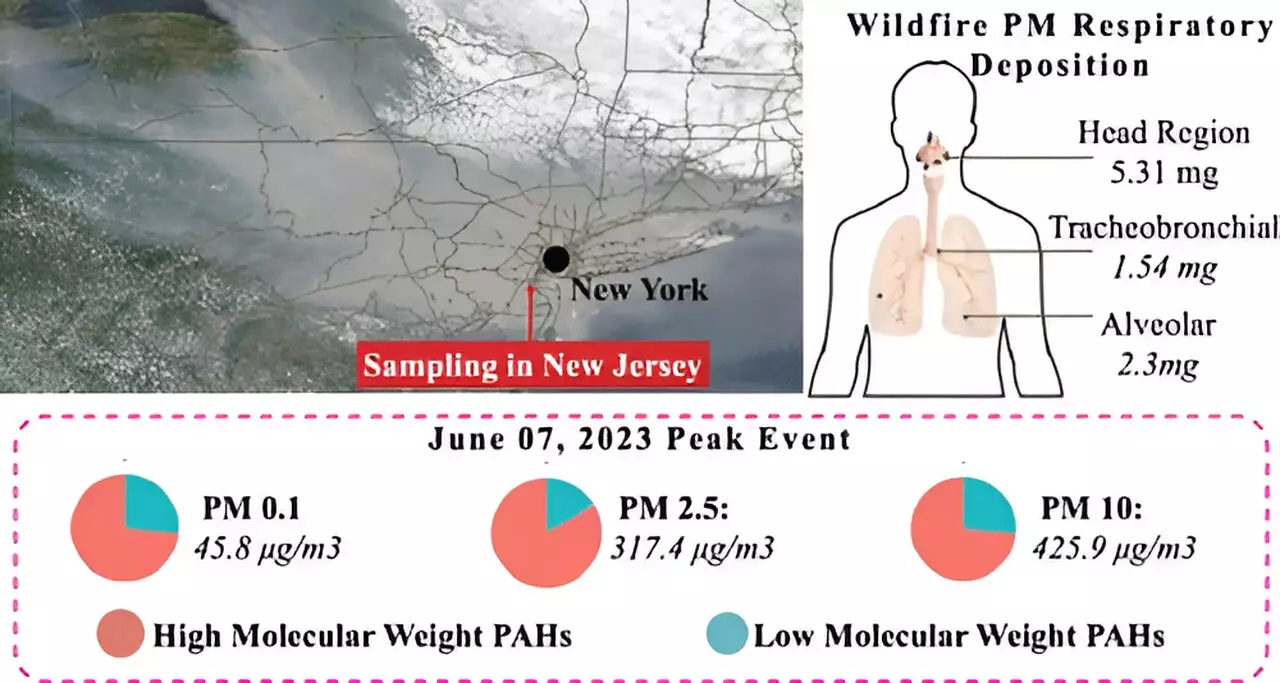The emergence of climate-driven wildfires has transformed air quality dynamics across the United States, particularly in regional densely populated areas such as the Northeast. A recent study conducted by researchers at Rutgers University highlights the alarming effects of wildfire-related particulate matter (PM) on human health and underscores the increasing significance of understanding these phenomena. The research not only characterizes the particulate matter emitted during a significant wildfire event in June 2023 but also connects this pollution to a wider public health crisis affecting millions of Americans.
In June 2023, a wildfire ignited, prompting air quality advisories for over 100 million residents in the Northeast, including populous urban centers like New York City and New Jersey. This incident serves as a stark reminder that climate change is not a distant threat; it is already reshaping our living environments and public health frameworks. Lead researcher Jose Guillermo Cedeño Laurent points out that wildfire smoke is increasingly recognized as a major environmental hazard, contributing significantly to respiratory and cardiovascular illnesses. With fires exacerbated by rising global temperatures, the implications for air quality are grim.
The Rutgers study stands out as the first to analyze the physical and chemical properties of particulate matter released from such a fire in this region. Through advanced scientific techniques, the research team identified dangerously high concentrations of polycyclic aromatic hydrocarbons (PAHs) during the peak of the wildfire, particularly on June 7. PAHs are known carcinogens, and their presence raises troubling concerns about the long-term health risks faced by communities affected by such fires. Moreover, the study revealed that concentrations of ultrafine and fine particulate matter exceeded national air quality standards by nearly tenfold, marking a historic deviation from the norm observed in the past five decades of air quality monitoring.
The correlation between wildfire-related air pollution and adverse health outcomes is an increasingly urgent issue. Epidemiological studies in New York City following the wildfire event have suggested a significant rise in emergency visits related to respiratory and cardiovascular conditions. The particulate matter’s small size allows it to penetrate deep into the lungs, exacerbating existing health issues and possibly introducing new ones. The data collected during the Rutgers study showed that the estimated inhalation dose of PM during a 72-hour exposure period was notably high, leading to serious health concerns.
The findings from the Rutgers research are not just academic; they serve as a basis for ongoing investigation into the health impacts of wildfire smoke. Further research is being conducted collaboratively across various institutions, targeting different organ systems affected by this pollution. For instance, studies are underway to assess how particulate matter influences lung functionality, cardiovascular health, brain activity, and even reproductive health. This multi-faceted approach aims to translate research findings into meaningful public health strategies and interventions.
The Rutgers team’s findings are pivotal for public health assessors and policymakers. Given that climate change is bound to exacerbate wildfire activities, understanding the unique characteristics and risks associated with wildfire particulate matter becomes essential for developing effective health risk evaluation protocols. Demokritou, a co-author on the study, stresses the need for communities, particularly those with pre-existing air quality challenges, to adapt and implement proactive measures in response to the increasing frequency of wildfires.
As the discussion continues regarding the ramifications of wildfire smoke on urban populations, it is critical to shift our focus toward long-term strategies. Ongoing studies, including one aimed at assessing how wildfire-related PM affects global warming and climate dynamics, will provide essential insights for future policymaking and environmental regulations. The collaboration among various health and scientific institutions presents an opportunity to create a comprehensive understanding of these complex issues, ultimately leading to improved public health responses.
The Rutgers study sheds light on a growing concern: the intricate relationship between climate-driven wildfires, air quality, and public health. As wildfires continue to ravage ecosystems and communities, the findings emphasize the urgent need for vigilance and preparedness in the face of changing environmental conditions. The health risks associated with airborne particulates are considerable, and addressing them requires an integrated approach focused on public health, environmental science, and community resilience.


Leave a Reply